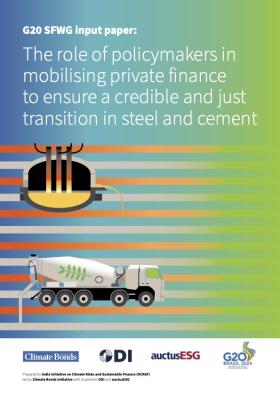
To reach Paris Agreement climate targets, high-emitting industries like steel and cement must rapidly transition their operations to net zero. This transition will be a challenge, but also provides a tremendous opportunity for investors and companies to develop sustainable and resilient industries.
To support this transition, Climate Bonds has produced a new guidance paper outlining the role of policymakers in mobilising private finance to ensure a just transition in steel and cement.
This paper responds to the request of the G20 Sustainable Finance Working Group (SFWG) to explore the role of policymakers in mobilising private finance to ensure a credible and just transition in steel and cement, and how credible transition plans are the means to access private capital required for the transition of both sectors.
The G20 SFWG aims to mobilise sustainable finance as a way of ensuring global growth and stability and promoting the transitions towards greener, more resilient and inclusive societies and economies. The group is tasked to identify institutional and market barriers to sustainable finance, develop options to overcome such barriers, and contribute to a better alignment of the international financial system to the objectives of the 2030 Agenda and the Paris Agreement.
This is the decade of change for steel and cement
 The steel and cement industries are the two largest industrial emitters, accounting for a combined 13% of global emissions. Transitioning these industries will be pivotal to meeting our Paris Agreement objectives and securing a net zero future.
The steel and cement industries are the two largest industrial emitters, accounting for a combined 13% of global emissions. Transitioning these industries will be pivotal to meeting our Paris Agreement objectives and securing a net zero future.
While these industries are currently very highly emitting, there are tremendous opportunities to transition steel and cement production. This decade is crucial to the transition of these sectors, with over 70% of coal-based steel blast furnace capacity needing reinvestment by 2030.
Most of this reinvestment will be needed in emerging markets, offering a significant opportunity for these markets to switch to lower-intensity production methods this decade. With demand for steel and cement projected to rise over 30% and 45% respectively by 2050, especially in emerging markets, developing more sustainable methods of production will be crucial to meeting Paris Agreement targets.
Policymakers hold the keys to unlocking private capital
As the major consumers of steel and cement, governments have significant leverage in their transition. Public authority purchasing power totals around USD11tn each year, and public procurement accounts for up to 25% of steel and 40% of cement global demand.
Policies such as green public procurement can create a favorable market for low-carbon and innovative products. This would provide more certainty to companies and investors, driving large-scale, price-reducing demand for green products and more ambitious transition plans.
One crucial tool for ensuring the rapid transition of the steel and cement sectors is the use of credible transition plans. GSS+ bonds are being issued to an increasing extent in the steel and cement sectors, but represent only 7.2% and 11.8% of all volume, respectively. Part of the reason their potential has not been fully realized, particularly for sustainability-linked bonds (SLBs) is the lack of standards — notably, sector-specific criteria.
Transition plans are increasingly becoming an integral part of the screening methodologies employed by financial institutions, which, due to recent legislation such as the Corporate Sustainability Due Diligence Directive (CSDDD), are required to prepare and document their own transition plans.
Accordingly, financial opportunities will be determined by the availability and credibility of corporate transition plans, which are increasingly becoming a license to operate in the net zero economy. Further improving the alignment of transition plans and bond frameworks, especially for SLBs, is critical to unlocking financing opportunities in hard-to-bate sectors.
Credible transition plans support credible SLBs, thereby facilitating the financing of the transition in the steel and cement sectors. All steel sector SLBs and 80% of those for the cement sector are issued by companies that include three key elements of transition plans (action plan, finance plan, and government mechanism) aligned with Climate Bonds’ methodology.
The G20: An opportunity for collaboration, guidance, and progress
The G20 Sustainable Finance Working Group discussions provide an opportunity for the international community to hasten and facilitate the transition of the steel and cement sectors. By developing an international understanding of the core elements of a just transition, the international community can encourage the rapid, credible, and just transition of these sectors. Companies within these sectors are currently subject to different legislative frameworks, and would benefit from increased coordination among major countries.
The G20 Sustainable Finance Working Group also has the opportunity to provide guidance on just transition challenges and opportunities in these sectors, promoting best practices across the industries. In order to accomplish this, they must engage with steel and cement companies directly to assess their industry-specific needs.
